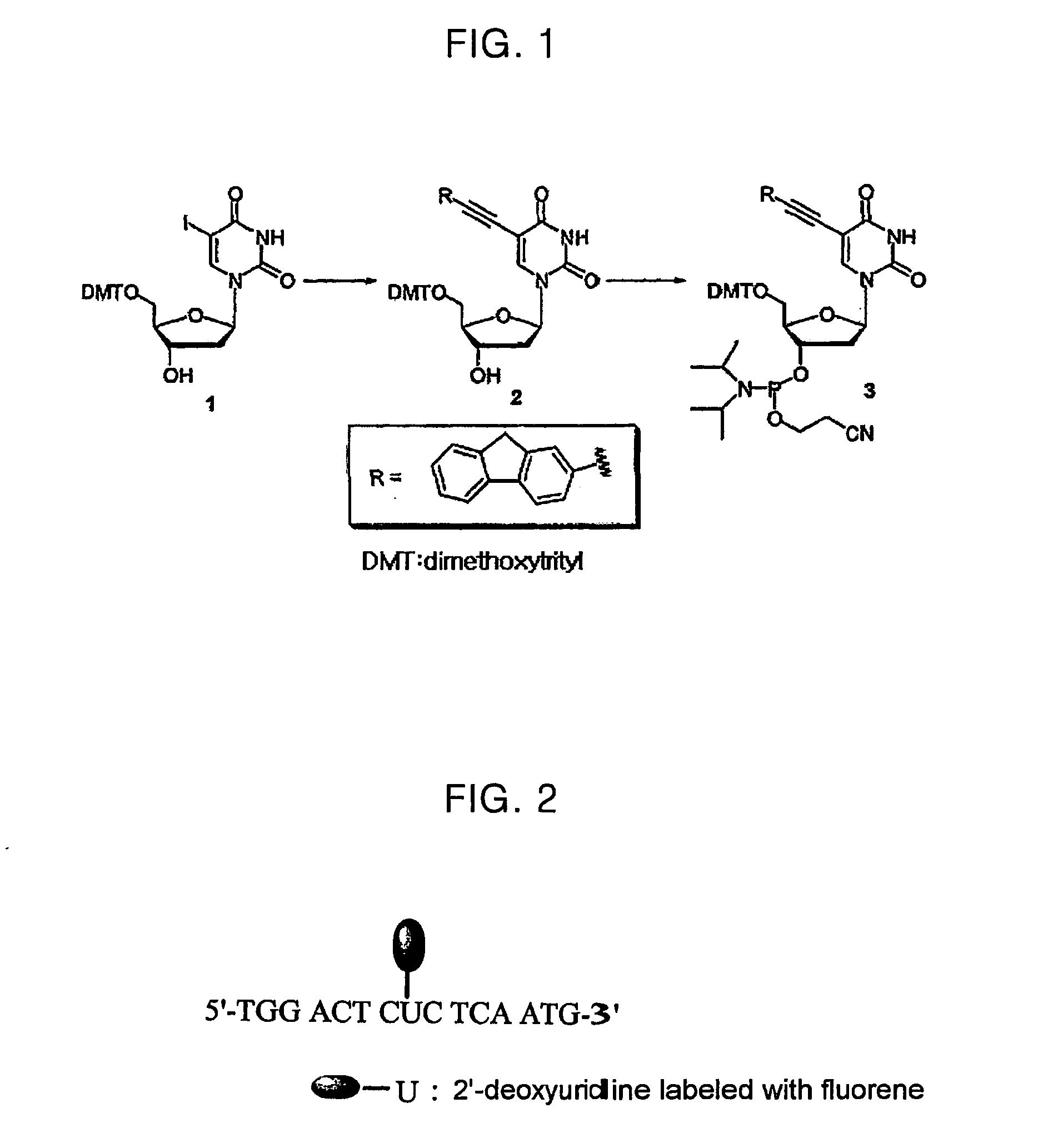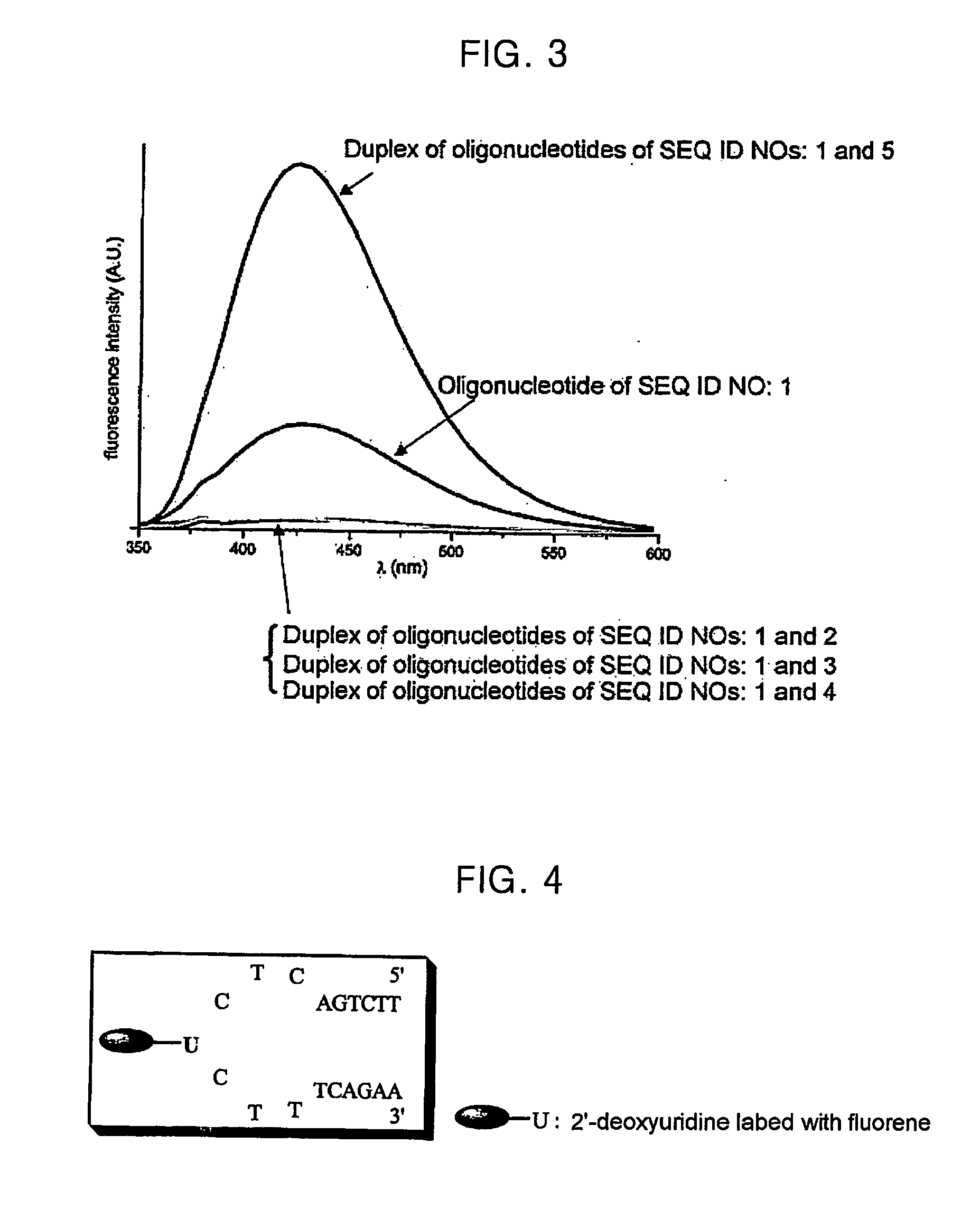Oligonucleotide For Detecting Target Dna Or Rna
a technology of oligonucleotides and targets, applied in the field of oligonucleotides for detecting targets dna or rna, can solve the problems of complex and costly process, no room for attaching any useful functional groups,
- Summary
- Abstract
- Description
- Claims
- Application Information
AI Technical Summary
Benefits of technology
Problems solved by technology
Method used
Image
Examples
example 1
Preparation of 2′-deoxyuridine labeled with fluorophore
[0030] (1-1) Preparation of 5′-O-[Bis(4-methoxyphenyl)phenylmethyl]-2′-deoxy-5-(2-ethynylfluorenyl)uridine
[0031] (PPh3)2PdCl2 (53 mg, 0.076 mmol) and CuI (14 mg, 0.074 mmol) were added to a solution obtained by dissolving 5-iodo-5′-dimethoxytrityl-2′-deoxyuridine (497 mg, 0.757 mmol) (See compound 1 of FIG. 1) and 2-ethynylfluorene (231 mg, 1.21 mmol) in Et3N (4 mL) and THF (12 mL). Argon was bubbled through the mixture for 2 min, and the mixture was subjected to ten (10) pump / purge cycles. Then, the mixture was stirred at 45 to 50° C. for 2 h, and the solvent was evaporated under a reduced pressure. The resultant residue was subjected to column chromatography (Merck 60 silica gel, 230-400 mesh) using the eluting solution of hexane / EtOAc(1:5), to obtain the title compound (434 mg, 80%), which was recrystallized from CHCl3 / MeOH (1:1) (See compound 2 of FIG. 1)
[0032] M.p. 160-161° C.
[0033] [α]14D=+40° (c=1.05, CHCl3).
[0034] I...
example 2
Synthesis of the oligonucleotides of the Present Invention
[0046] The compound obtained in Example (1-2) was introduced as a building block to prepare the fluorescent oligonucleotides of SEQ ID NOs: 1 and 6 on a Controlled Pore Glass 9CPG solid support by the phosphoramidite approach using an automated DNA synthesizer (PerSeptive Biosystems 8909 Expedite™ Nucleic Acid Synthesis System). The oligonucleotides prepared were characterized by MALDI-TOF mass spectrometry as follow:
[0047] The oligonucleotide of SEQ ID NO: 1, calcd m / z 4717, found 4723; and the oligonucleotide of SEQ ID NO: 6, calcd m / z 5903, found 5903.
[0048] Further, the oligonucleotides of SEQ ID NOs: 2 to 5, 7 and 8, candidate target DNAs, were prepared using the same automated DNA synthesizer.
TABLE 1Base sequence (5′→3′)Oligonucleotide ofTGG ACT CN* C TCA ATGSEQ ID NO: 1Oligonucleotide ofCAT TGA GTG AGT CCASEQ ID NO: 2Oligonucleotide ofCAT TGA GGG AGT CCASEQ ID NO: 3Oligonucleotide ofCAT TGA GCG AGT CCASEQ ID NO: 4...
example 3
The measurement of Fluorescence Intensity
[0051] The fluorescent oligonucleotides of the present invention (SEQ ID NOs: 1 and 6) were examined in terms of whether they can be used to detect a target having completely matched or single-base mismatched base sequence, as follows:
[0052] The oligonucleotide of SEQ ID NO: 1 was hybridized with each of the oligonucleotides of SEQ ID NOs: 2 to 5, in a molar ratio of 1:1 in a buffer (100 mM NaCl, 20 mM MgCl2 and 10 mM Tris-HCl buffer (pH 7.2)), and its steady-state fluorescence (FL) spectrum was taken with a MD-5020 PTI model microscope photometer using a bandwidth of 15 nm and 0.5×2 cm quartz cuvettes with a light pass of 1 cm. The cell holder was thermostated with circulating water controlled by a PolyScience digital temperature controller 9110. The fluorescence measurement was carried out in the same buffer as used in the hybridization. Fluorescence emission spectra are shown in FIG. 3. The fluorescence intensities measured at λmax of 42...
PUM
| Property | Measurement | Unit |
|---|---|---|
| stem-loop structure | aaaaa | aaaaa |
| fluorescence | aaaaa | aaaaa |
| torsional force | aaaaa | aaaaa |
Abstract
Description
Claims
Application Information
 Login to View More
Login to View More - R&D
- Intellectual Property
- Life Sciences
- Materials
- Tech Scout
- Unparalleled Data Quality
- Higher Quality Content
- 60% Fewer Hallucinations
Browse by: Latest US Patents, China's latest patents, Technical Efficacy Thesaurus, Application Domain, Technology Topic, Popular Technical Reports.
© 2025 PatSnap. All rights reserved.Legal|Privacy policy|Modern Slavery Act Transparency Statement|Sitemap|About US| Contact US: help@patsnap.com



